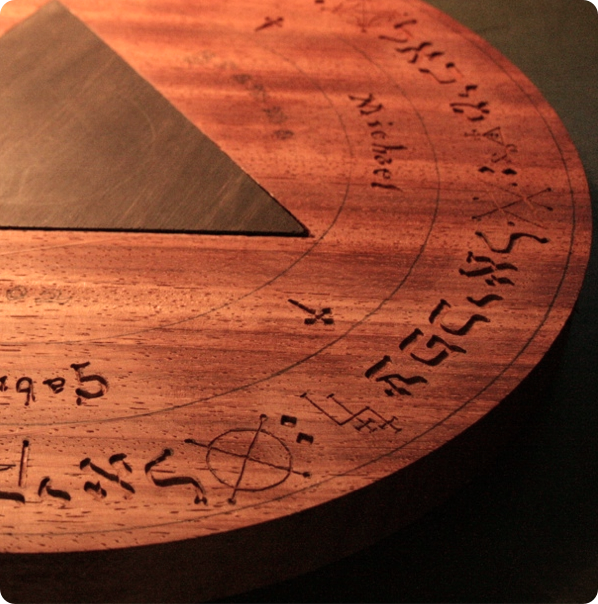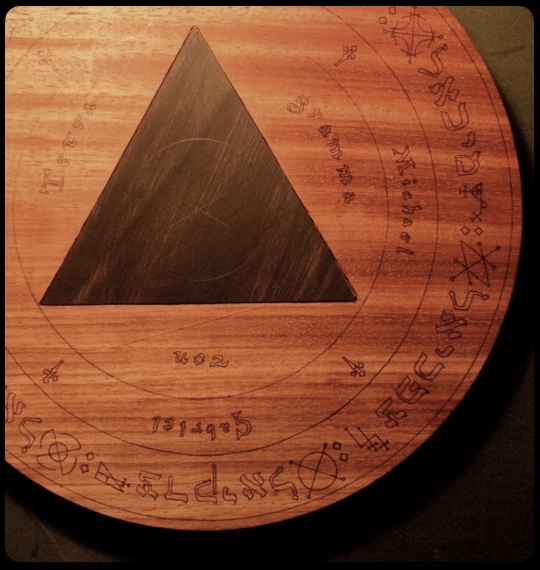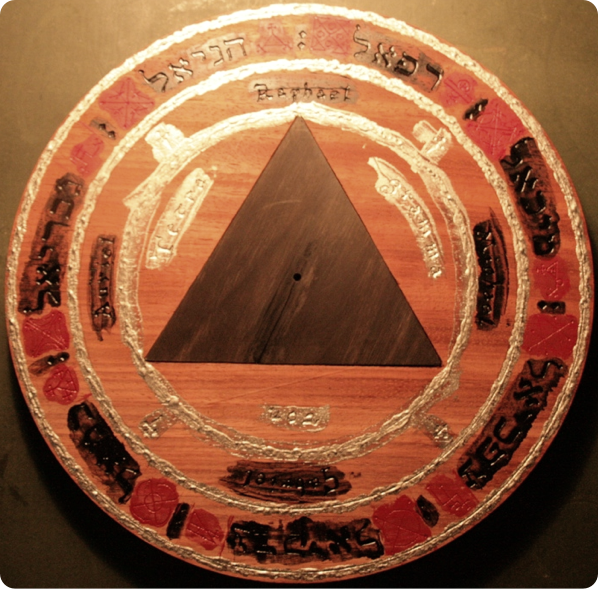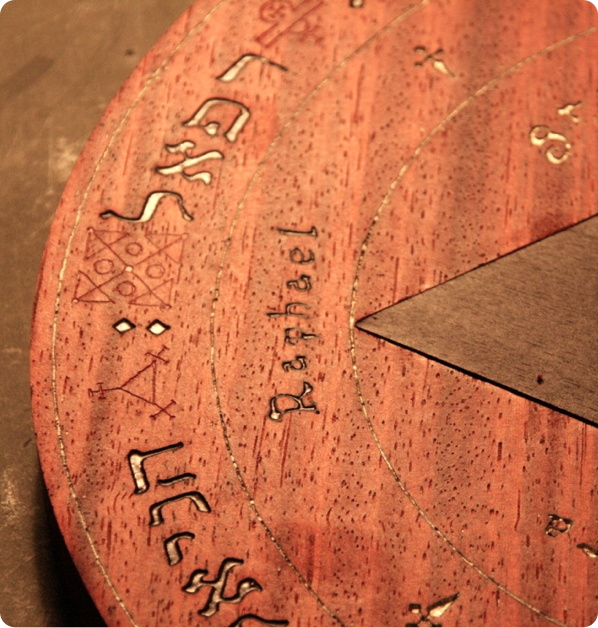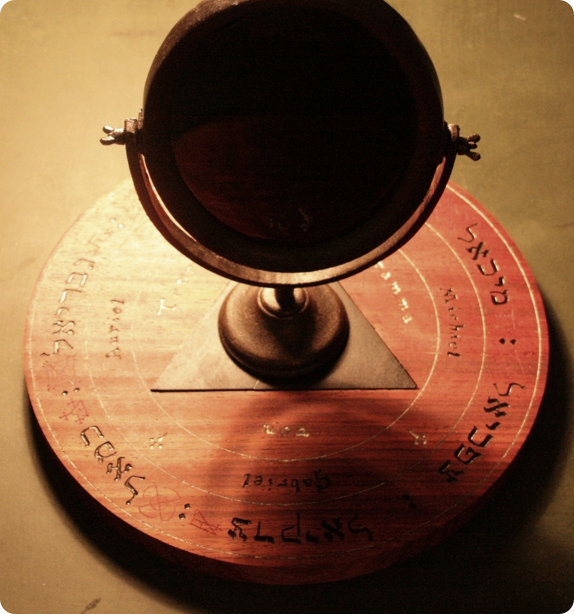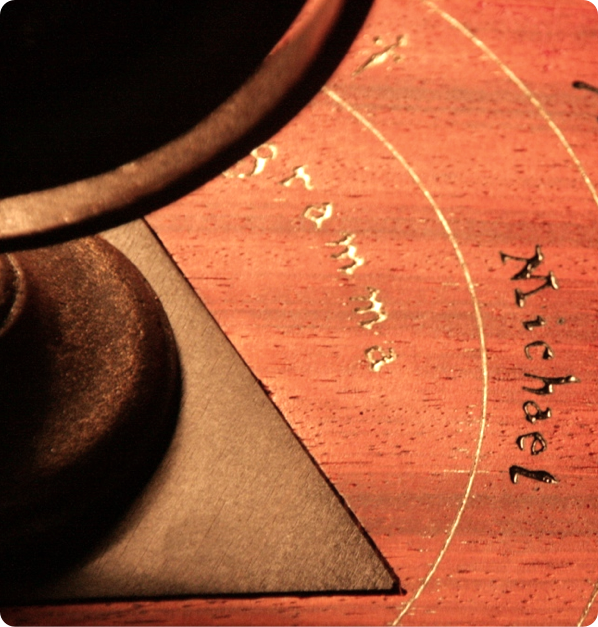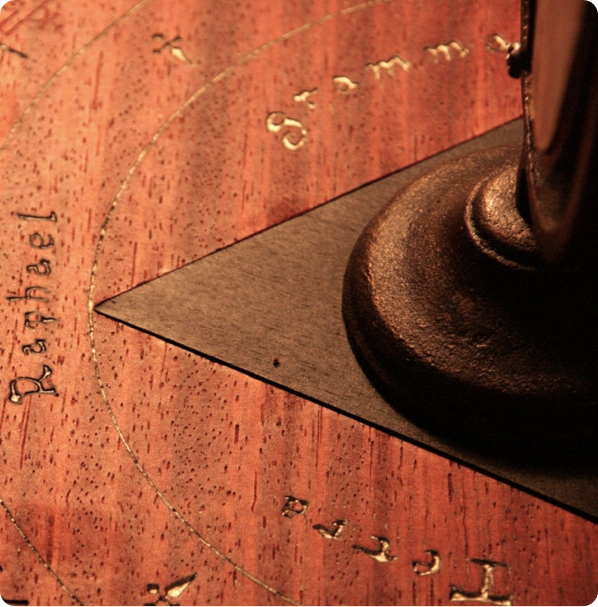Trithemius' Table of Practice
An excercise in magical handcraft
In late 2009 a friend and I had set out to perform the Arbatel rituals of conjuring the Olympic Spirits. A lot of material has been published on this subject both offline and online and I have my own ritual accounts here.
When approaching this project, however, I decided to take a slightly different stance: Rather than performing the Arbatel rituals for reasons of personal material gain or spiritual support, my focus should be entirely on understanding the nature of the Olympic Spirits themselves by use of direct ritual communication. The series of rituals therefore was conceived as an exploration into the nature of the Olympic Spirits through questions and answers.
It was in light of this context that we decided to use an evocative approach to these rituals - and Trithemius’ Table of Practice as the centre of the operations. Our goal was to conjure the Olympic Spirit into the crystal (or black magic mirror in my case) and use this magic device as the link for mental communication with the Olympic Spirits.
This text is dedicated to the description of how we crafted Trithemius’ Table of Practice to our best abilities over the course of several months.
1) The Design
The design of Trithemius’ Table of Practice is described in the small volume “The Magic and Philosophy of Trithemius Spanheim: Containing his Book of Secret Things and Doctrine of Spirits”. We used the beautifully bound copy published by Hell Fire Club Books. However, the text most well known source is as an appendix to The Magus from Francis Barrett, a copy of which can is also available online here on Joseph Petersons Sacred Texts.
The actual description of the crystal table is relatively short:
Procure of a lapidary good clear pellucid crystal, of the bigness of a small orange, i. c. about one inch and a half in diameter; let it be globular or round each way alike; then, when you have got this crystal, fair and clear, without any clouds or specks, get a small plate of pure gold to encompass the crystal round one half; let this be fitted on an ivory or ebony pedestal, as you may see more fully described in the drawing, (see the Plate, fig. I.) Let there be engraved a circle (A) round the crystal with these characters around inside the circle next the crystal; afterwards the name "Tetragrammaton". On the other side of the plate let there be engraven "Michael, Gabriel, Uriel, Raphael;" which are the four principal angels ruling over the Sun, Moon, Venus and Mercury; but on the table on which the crystal stands the following names, characters, &c. must be drawn in order. First, The names of the seven planets and angels ruling them, with their seals or characters. The names of the four kings of the four corners of the earth. Let them be all written within a double circle, with a triangle on a table; on which place the crystal on its pedestal: this being done, thy table is complete (as in the Fig. D,) and fit for the calling of the spirits (...)
On first reading it was clear we needed to amend this design to fit our budgets and purpose. In the original description the whole device is made up of four elements: the crystal, the gold plate, the ivory/ebony pedestal and the table. While we were committed to staying true to the essence of the original, we had to amend the design to match our limited crafting skills as neither of us is a goldsmith nor a carpenter.
After several weeks of study we landed on a design that brought all the carvings together on a horizontal wooden table onto which the actual crystal would be placed. As we had set out to design a table each, we decided to create one fit for a crystal and the other fit for a black mirror.
The actual elements of the carvings are given as follows:
- These 3 symbols inside a circle around the crystal:
- The Tetragrammaton next to or around the three symbols
- Then the names of the 4 archangels, Michael, Gabriel, Uriel and Raphael
- On the opposite side of the table the “names, characters, etc.” (sic!) of:
- the seven planets with their seals,
- the ruling angels with their seals and
- the names of the four kings of the four corners of the earth
Of course at the end of the day the whole table had to fit on our altar in the middle of the circle of art. After measuring the maximum space we could give to the table it turned out it couldn’t measure more than 13 inch (30cm) in diameter. Secondly, we knew we wanted to create the whole table from wood and carve all seals, characters and names on it - rather than just painting or drawing them on. Thus we tested carving magical seals into wood with a standard Dremel device and the finest drill applicable. This allowed us to understand the maximum amount of elements in our design that would fit onto a wooden disc of 13 inch diameter.
After these practical considerations we went back to the drawing board and came up with the following design:
We clearly took artistic freedom here and e.g. brought together the seals of the front and back of the table as well as the table and the pedestal on one single surface. We also decided to dropp the names of the four kings of the corner of the earth; it would have simply congested the design we had in mind. However, we still felt confident as this version created a full magical circle around the actual crystal. This was a desired effect as the crystal would be used as the locus of manifestation and would be placed inside our circle of art on the altar. Thus any spirit materializing in the crystal would be bound by the circle, names and seals on the Table of Practice. - Here is a schematic overview of the structure of the ritual space we had in mind when using the Table of Practice in future rituals:
2) The Materials
With regards to the materials used it was obvious that embedding our crystal into a gold plate wouldn’t be possible. Ivory on the other hand didn’t come into question due to ethical reasons and - more practically - we would not have had the means to craft a fitting pedestal from it.
After several weeks of study on the internet we settled on two types of wood that seemed to be a good compromise with regards to density, color, texture and our ability to craft a crystal table from them. This was Pardouk as the base of the table and Ebony as the triangle embedded into it onto which the actual crystal would be placed.
3) The Production
The production process basically followed eight stages which each got tested before we applied it to our tables.
- Pre-cutting of table (Pardouk) and inset triangle (Ebony) wood
- Excavating the inset triangle space from the ground table
- Plane fitting of the ebony triangle into the ground table
- Copying of design onto ground table
- Drilling the design into the ground table wood
- Filling the drillings with dry and opaque colors
- Abrasive finishing
- Excavating the hollow from the ebony triangle (Crystal version) / Screwing the black magic mirror on top of the ebony triangle (Mirror version)
The pre-cutting was done by a professional carpenter for us. There was simply no way we could have cut that size of Pardouk to a downright circle of 13 inches. Equally, ebony is very hard and dry wood. Cutting it into the equilateral triangle that would be fitted into the ground plate of Pardouk had to be done with professional machines. The results, however, were great.
Then we got out hands on the wood and started to excavate the space of the equilateral triangle from the table base. Neither of us had done this work before and so we were extremely careful in order to achieve the right shape and depths. The goal was to create an ebony inlay that was absolutely smooth and plane.
Copying the design onto this raw table turned out to be more difficult than expected. Mostly because of the size of the design: it didn’t fit on a single piece of paper and the circle on the outside of the table as well as the circle around the triangle had to be very exact. I still remember the day when we sat together in my living room - dozens of photocopies of the design around us, all in different sizes matched onto two DinA4 papers stuck together, manifold paper blackening our fingers... and very far away from the exact blueprint we needed for our tables. Finally, however, it worked out and we were ready to take the tables back into the barn behind my house to start drilling the design into the wood.
Once we got used to it, the actual carving of the hebrew names as well as the archangel names was much easier than we had thought. However, it was the more intricate design of the filigree circles and seals that gave us a hard time. For each seal we only had one try to get it right or to mess up the entire table.
The next stage was easy compared to the previous one. Yet, again everything was the first time and we didn’t know how the colors would enhance or ruin the design. Ideally we wanted them to look like inlays rather than colors. However, even after visiting multiple artist shops we weren’t exactly sure that we had chosen the best possible solution... Once we applied the color things got worse. It was impossible to spot wether we enhanced the design or just ruined the whole thing. So we went through the entire process patiently, applied all colors in sequence and waited until they were fully dried. Only then did we polish all superfluous color off and brought the even surface of the table out again.
The final stage was to screw the black mirror on top of the Table of Practice. As mentioned above, we built two versions. One for a crystal ball and one for a mirror; as mine is the later you only get to see these pictures here. - I should also mention that I had to leave away the three symbols in the corners of the ebony triangle. The wood simply proved to be so dry at that point that any further carving would have made it break. Similarly I didn’t want to paint them onto the beautiful black wood as this was against the entire spirit of the project and wouldn’t have done justice to the surface of the ebony. Thus I decided less was more and finished the Table of Practice.
“If it doesn’t work it is not worth pursuing, but if it does work then it is worth pursuing thoroughly.” (Skinner & Rankine, The Keys to the Gateway of Magic, p.11)
Note: It might be worthy pointing out that the mirror was a different project itself. The surface is created according to Franz Bardon’s instruction for physical condensers and then coated with black paint in multiple layers.
Selected Resources
- Bardon, Franz, Die Praxis der Magischen Evokation, Hermann Baur Verlag, 1982
- Bardon, Franz, Der Weg zum Wahren Adepten, Hermann Baur Verlag, 1982
- Magian Rumination, Everything Arbatel - Digest of Internet Links
- McLean, Adam (ed.), A Treatise of Angel Magic, Weiser Books, 2006
- Northcote, Thomas, Crystal Gazing, The De La More Press, 1905
- Peterson, Joseph (ed.), Arbatel - Concerning the Magic of the Ancients, Ibis Press, 2009
- Runyon, Carroll Poke, The Book of Solomon’s Magic, Church of Hermetic Sciences, 2008
- Skinner, Stephen & Rankine, David, The Keys to the Gateway of Magic: Summoning the Solomonic Archangels and Demon Princes, Golden Hoard Press, 2005
- Trithemius, The Magic and Philosophy of Trithemius Spanheim: Containing his Book of Secret Things and Doctrine of Spirits, Hell Fire Club Books, 2008





